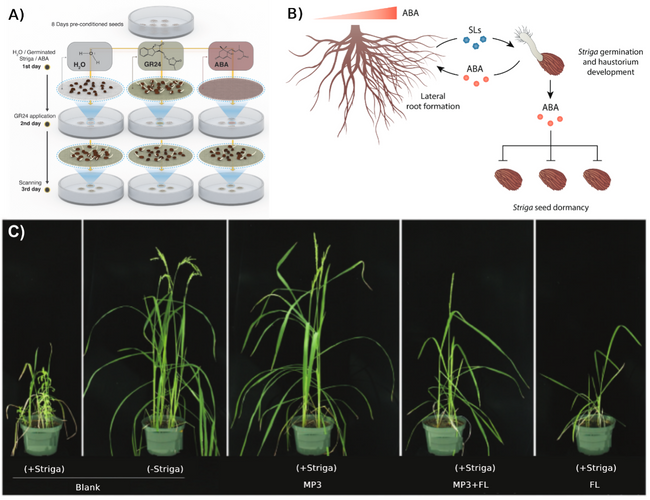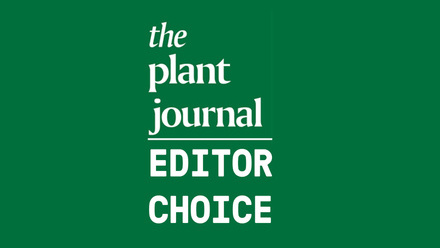TPJ Editor choice: February 2024
https://doi.org/10.1111/tpj.16610
It’s not witchcraft: the role of abscisic acid for Striga germination and conditioning
Striga is a parasitic plant that attacks roots of crop plants, including sorghum, maize and rice, across Africa, India and Australia. After germination, Striga attaches to the host roots with a specialized organ and takes up water and nutrients from the host, which can lead to a slow death of the host plants. Because the symptoms of a Striga infestation are visible on the host plants earlier than the parasite breaks out from the soil, Striga was named “witchweed”. Striga seeds remain dormant in the soil for years, until they experience specific environmental conditions to prepare them for germination: a temperature of around 30°C and a moist environment for one to two weeks. Then, they are able to perceive signals from the host plants to start their germination. The most famous germination stimulant is strigolactone, but treatment with cytokinin also triggers germination. Even though it is known that treatment with the abscisic acid (ABA) biosynthesis inhibitor fluridone (FL) shortens the seed conditioning period and increases the responsiveness to germination stimulants, it is not known which role ABA plays in Striga germination.
Muhammad Jamil, Jian You (Eric) Wang, Yagiz Alagoz and colleagues, under the lead of Salim Al-Babili, addressed the question of how Striga hermonthica seed dormancy and germination are correlated with endogenous ABA levels. They treated unconditioned Striga seeds with FL in presence or absence of a strigolactone analogue and found that each chemical alone resulted in germination of 8-13 % of the seeds, while when combined they induced germination in 70 % of the seeds. This suggests that inhibiting ABA biosynthesis is sufficient to trigger seed germination and shortens the conditioning phase. Striga seeds release ABA as part of the germination process, therefore, the authors determined the ABA content in Striga seeds as well as in the seed exudates after exposure to FL, strigolactone and ABA. They found that Striga seeds released ABA early in the conditioning process, and that strigolactone application did not increase the release of ABA. However, in the late stage of conditioning, strigolactone application and thereby the induction of germination led to an accumulation of endogenous ABA and its release.
The authors next analysed the role of ABA in the germination process. They applied a strigolactone analogue alone or with different doses of ABA to seeds conditioned for 2 or 8 days and measured their germination. The germination decreased with the increase of ABA concentration, but seeds conditioned for 8 days were less inhibited than those conditioned for 2 days. This suggests that ABA acts as a germination inhibitor, particularly in unconditioned Striga seeds. But what role does the released ABA play? To test the impact on surrounding Striga seeds, the authors placed Striga seeds in days 0-7 of the conditioning phase around a disc covered with germinated seeds or a disc soaked with ABA as control. Both discs inhibited the germination of surrounding conditioned seeds, and the inhibition was highest in seeds conditioned for a short time. This mechanism might provide a competitive advantage for the germinated seed over unconditioned seeds or seeds in an early conditioning phase, maximizing the exploitation of resources. Additionally, the authors found that placing germinated Striga seeds next to host roots promoted root growth and increased the number of lateral roots growing towards the seeds. Therefore, ABA not only plays a role in conditioning and germination endogenously but also in exudates to manipulate surrounding seeds and the host root architecture. The increased number of host lateral roots growing towards the ABA released by the germinated Striga seeds might increase the chances of Striga attachment to the host root system.
With this knowledge, the authors went on to test how ABA can be used for combating Striga infestation. “Suicidal germination” is a term that refers to applying strigolactone analogues to a Striga-infested field in the absence of a host, which leads to the death of the emerging obligate parasite Striga seedlings and, hence, cleans infested soil. The authors found that ABA inhibitors can function as suicidal germination agents, because they can break seed dormancy even before conditioning. Combined with other hormones such as strigolactones, the treatment might even be more efficient to fight Striga infestation in the field.

Figure 1: Abscisic acid (ABA) is released during Striga germination and inhibits conditioning and germination of surrounding seeds.
A) Experimental setup to measure the effect of ABA on germination of pre-conditioned Striga seeds. Discs with pre-conditioned Striga seeds treated with water, discs with germinated Striga seeds, or discs with ABA were placed in the centre, between discs with pre-conditioned Striga seeds.
B) Conditioned Striga seeds germinate after perceiving signals released by the host plants (strigolactones, SLs); after germination, Striga seeds release ABA to inhibit conditioning and germination of surrounding Striga seeds and to manipulate the host root architecture.
C) To test chemicals for suicidal germination, host plants were grown in pots together with pre-conditioned Striga seeds supplied with potential suicidal germination agents, i.e. the strigolactone analogue MP3 and the ABA biosynthesis-inhibitor fluridone. Figure modified from (Jamil et al., 2024)



